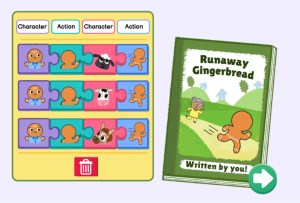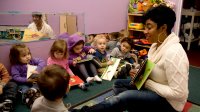Using Stories to Support Computational Thinking
Breaking stories down into parts is a handy way to teach preschool students about structure, logical reasoning, and sequencing.
Your content has been saved!
Go to My Saved Content.Computational thinking (CT) is a creative way of thinking that empowers children to be systematic problem-solvers, enabling them to identify problems and then brainstorm and generate step-by-step solutions that can be communicated and followed by computers or humans. Thanks to funding from the National Science Foundation, our teams at GBH and Education Development Center have had the opportunity to be at the forefront of the burgeoning field of preschool CT.
Over several research and development projects, we have explored how to support hands-on CT experiences in school and home settings, including how to integrate CT into preschool math instruction, promote joint-media engagement between parents and children, and, most recently, incorporate it into preschool classroom storytelling experiences, with the goal of supporting computational literacy—the ability to use CT skills to create real-world artifacts and express one’s self while making sense of the world.
Using Stories to Approach Computational Thinking
Narrative storytelling is an excellent framework for supporting computational literacy. As part of their instruction, teachers commonly break down stories into parts, or what we call story elements (for instance, characters, actions, and consequences). This type of decomposition can help children understand the structure of stories, see the logical connections among elements, and create a coherent story by stringing together a series of characters, actions, events, and consequences in meaningful ways.
Our project focuses specifically on stories, such as “The Gingerbread Man,” which have repetitive, predictable patterns. In this story, the Gingerbread Man always meets different characters, who always want to eat him, and then he always runs away. To scaffold this process of thinking computationally, our team has developed learning resources that offer children multiple opportunities to identify the story pattern. This pattern then gives children the step-by-step instructions, or an algorithm, for creating a story. Using this pattern, they can change the story elements to create a new version of the story.
Each story is explored using a five-step model:
1. Teachers and children read a story with a repetitive and predictable pattern.
2. They use picture cards to break down the story into smaller elements, such as character and action.
3. They create a story-pattern chart, a visual representation of how the story elements repeat predictably.
4. They follow along with the story chart to retell the story.
5. They use the same pattern but with different story elements to create a new story.
During whole-group activities, teachers model CT for children as they read the stories and create the story chart, which is used as a central discussion piece to scaffold the decomposition of the story’s algorithm. In follow-up small-group activities, children use mini-story charts and a digital app to engage in the playful act of riffing on the familiar by swapping in new elements to change their story. They also re-create the story using manipulatives like puppets or small toys.

Additional resources help educators understand what types of instructional practices support the integration of CT into storytelling; how children can participate in the creative, expressive process of sharing their own story ideas while using CT; and how best to support dual-language learners and children with learning and thinking differences.
Over the past two years, classroom observations, expert reviews, and teacher feedback have informed the development of our project. Utilizing these early findings, we have come up with several ways in which teachers can support CT.
4 Simple Ways Teachers Can Reinforce CT
1. When reading a story, teachers can help children identify the important elements. Who is this story about (the character)? What is the character doing (the action)? What happened because the character did something (the consequence)? Helping children identify these elements, and the connections among them, can support their ability to break down stories into parts (the CT skill decomposition) and their understanding of how one action or event—a cause—brings about another—an effect (the CT skill of logical reasoning).
2. Teachers can apply the five-step model to help students analyze any story. As one teacher told us, “It’s basically a five-piece puzzle that can be used and reused with different books to help children understand the simple elements of literacy.”
3. When teachers point out positional and ordinal words, it helps children develop an understanding of CT vocabulary. Emphasizing what comes first, second, third, and last, while also using words like then and next, as children line up, go over the daily schedule, have a snack, or clean up throughout the day, reinforces their knowledge. Calling attention to the order in which things are done also can help children develop an understanding of the CT skill of sequencing.
4. Encouraging students to physically act out the stories can help them understand their meaning. For instance, during dramatic play time, children can use toys to demonstrate what character and action mean. This is particularly helpful for dual-language learners and children with learning and thinking differences.
Future research will allow us to get back into classrooms next spring to see how the use of the five-step model over a longer period of time can support children’s computational literacy and narrative storytelling.
